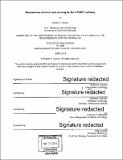Mechanisms of amino acid sensing by the mTORC1 pathway
Author(s)
Saxton, Robert A. (Robert Andrew)
DownloadFull printable version (15.74Mb)
Other Contributors
Massachusetts Institute of Technology. Department of Biology.
Advisor
David M. Sabatini and Thomas U. Schwartz.
Terms of use
Metadata
Show full item recordAbstract
In order to coordinate growth with organismal physiology, cells must couple anabolic and catabolic metabolism with a variety of environmental cues. In humans, cell growth is controlled primarily by the mechanistic Target of Rapamycin Complex 1 (mTORC1), which senses a diverse array of environmental inputs and in turn regulates nearly all aspects of growth and metabolism. Consistent with its central role in these processes, deregulation of the mTORC1 pathway is also associated with numerous diseases, including epilepsy, diabetes, and cancer. Although decades of study have revealed how growth factor signaling networks regulate mTORC1, the components that detect and signal nutrient availability to mTORC1 have been elusive until the recent discovery of the leucine and arginine sensors, named Sestrin2 and CASTOR1, respectively. However, the molecular mechanisms through which these components detect their respective amino acids have been elusive. To understand how Sestrin2 senses leucine and signals its presence to mTORC1, we solved the X-ray crystal structure of Sestrin2 in complex with leucine to 2.7 A resolution. This structure revealed how Sestrin2 recognizes leucine through a highly specific binding pocket, and utilizes a unique "lid-latch" mechanism to sense leucine. This structural data also allowed us to identify a highly conserved GATOR2-binding site on the surface of Sestrin2, in close proximity to the leucine-binding pocket, providing a plausible allosteric mechanism for the leucine-dependent dissociation of Sestrin2 from GATOR2. Using a similar approach, we then solved the crystal structure of arginine-bound CASTOR1 to 1.8 A resolution. This structure showed that CASTOR1 forms a homodimeric complex that engages arginine at the interface of two domains. Combining this structural information with various biochemical assays, we found that arginine acts as "molecular glue" that bridges these two domains together to allosterically modulate the adjacent GATOR2 binding site, thereby explaining the molecular basis for arginine-dependent mTORC1 activation. Together, the structural and biochemical characterization of Sestrin2 and CASTOR1 presented here have revealed for the first time the mechanisms of mammalian amino acid sensing in atomic detail. These structures have also paved the way for the development of novel compounds targeting mTORC1 through the Sestrin2 and CASTOR1 amino acid-binding pockets, which may have important clinical implications in the context of cancer, diabetes, neurological disorders, and longevity.
Description
Thesis: Ph. D., Massachusetts Institute of Technology, Department of Biology, June 2018. Cataloged from PDF version of thesis. "June 2018." Includes bibliographical references.
Date issued
2018Department
Massachusetts Institute of Technology. Department of BiologyPublisher
Massachusetts Institute of Technology
Keywords
Biology.